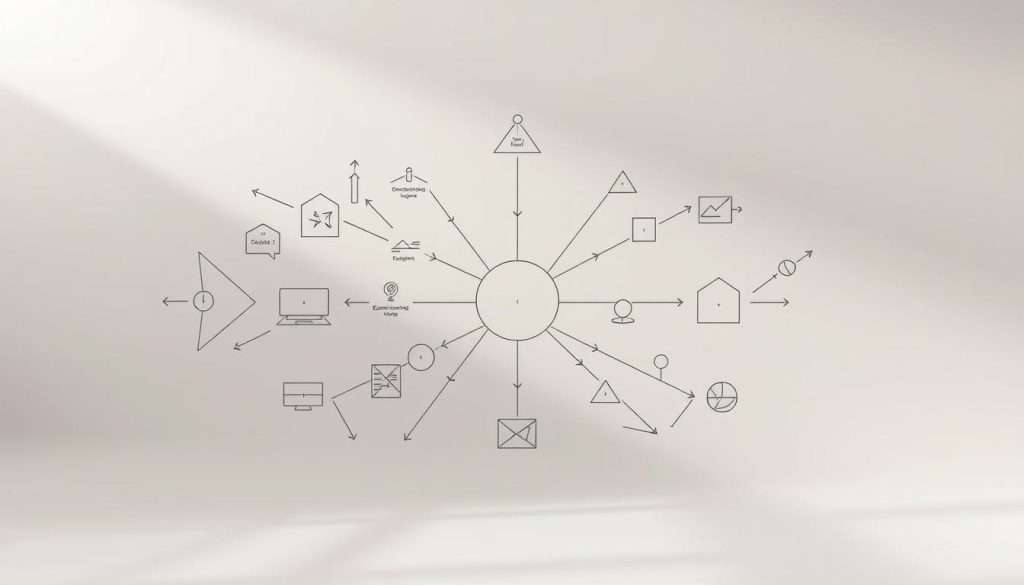We all aim to make better choices and think more clearly. But with so much info out there, it’s hard to know where to begin. That’s where mental models come in – they’re simple explanations for complex problems.
By applying mental models, we can simplify tough ideas. This makes it easier to enhance our thinking and make smart choices.
So, what exactly are mental models, and how do they boost our thinking skills? We’ll dive into the world of mental models and why they’re key to solving complex issues.
Key Takeaways
- Mental models simplify complex problems, making them easier to understand.
- Using mental models can improve decision-making.
- Mental models help break down complicated ideas into manageable bits.
- Enhancing thinking skills is crucial for making informed decisions.
- Mental models are essential tools for clear and effective thinking.
The Power of Mental Models in Decision-Making
Our minds are like navigators in complex waters. Mental models are the charts that guide us. They help us understand the world and make choices.
What Are Mental Models?
Mental models are frameworks that help us grasp the world. They are mental shortcuts for complex information. For example, a map is a mental model that shows us how to get from one place to another.
Why Mental Models Matter for Better Thinking
Having good mental models boosts our critical thinking. They let us see things from different angles. This way, we avoid narrow thinking and make better decisions.
The Difference Between Single and Multiple Mental Models
Using just one mental model is like having an old map. But, having many models lets us pick the best one for each situation. This flexibility is crucial for making smart choices.
Understanding the Concept of Mental Models
Mental models are key tools for understanding our world. They help us see and act in it. They are like lenses that shape how we view reality.
Mental Models as Thinking Frameworks
Mental models are frameworks in our minds. They help us organize and understand information. They are like maps for our thinking and decision-making.
By using mental models, we can simplify complex issues. We can spot patterns and make better choices.
How Mental Models Shape Our Perception
Mental models greatly affect how we see the world. They act as filters, deciding what we notice and how we see it. For example, if we see the world as competitive, we notice more competition and threats.
The Dangers of Limited Mental Models
Using only a few mental models can be risky. It limits our view of different perspectives and solutions. Expanding our mental model toolkit is key to improving our thinking and adapting to new situations.
| Mental Model | Description | Application |
|---|---|---|
| First Principles Thinking | Breaking down complex problems into fundamental principles | Innovation, Problem-Solving |
| Second-Order Thinking | Considering the potential consequences of those consequences | Decision-Making, Strategic Planning |
| Systems Thinking | Understanding complex systems and their interrelations | Analyzing Complex Problems, Policy Making |
How You Can Develop a Broad Set of Mental Models to Enhance Your Thinking
Building a wide range of mental models is a lifelong journey. It can greatly improve how you think. Both experts and beginners can benefit from this process.
The Process of Building Your Mental Model Collection
To start, you need to be curious and eager to learn. Read books, articles, and research papers from different fields. Interdisciplinary learning is essential for a broad set of mental models.
Integrating New Models into Your Thinking
After learning new models, you must practice using them. Apply these models to everyday problems. This helps you understand them better.
Creating a Personal Mental Model Inventory
Keep track of the models you learn by making a personal inventory. Use a journal or digital tool for this. Reflection is key to solidifying your knowledge and finding areas to grow.
By following these steps and staying committed to learning, you can build a wide range of mental models. These will boost your thinking and problem-solving skills.
Key Categories of Mental Models Worth Mastering
Learning many mental models can greatly improve your decision-making skills. To think critically and make smart choices, you need to know various models from different fields.
Scientific Mental Models
Scientific mental models come from the natural sciences. They help us grasp the world around us. For example, causality lets us study cause-and-effect, and entropy explains disorder and randomness.
Knowing about natural selection can give you insights into evolution. These models aren’t just for science. They apply to many areas of life and decision-making.
Economic Mental Models
Economic models explain how economies work and how resources are used. Key models include opportunity cost and supply and demand. These help set prices in markets.
Understanding these models can lead to better financial choices. It helps you see the economic side of your decisions.
Psychological Mental Models
Psychological models help us understand human behavior and emotions. For instance, cognitive dissonance shows how people deal with conflicting info. Anchoring bias explains how first info can shape later decisions.
Knowing these models can improve how you interact with others. It helps you make choices by spotting biases in your thinking.
Mathematical Mental Models
Mathematical models use math to understand real-world issues. Game theory helps us see strategic interactions. Probability theory lets us predict uncertain events.
These models are key for making choices when things are uncertain. They’re used in finance and engineering, among other fields.
| Mental Model Category | Examples | Application |
|---|---|---|
| Scientific | Causality, Entropy, Natural Selection | Understanding natural phenomena, decision-making |
| Economic | Opportunity Cost, Supply and Demand | Financial decisions, understanding market behavior |
| Psychological | Cognitive Dissonance, Anchoring Bias | Understanding human behavior, improving interactions |
| Mathematical | Game Theory, Probability Theory | Decision-making under uncertainty, strategic interactions |
“The most important thing in science is not so much to obtain new facts as to discover new ways of thinking about them.” – William Bragg
By mastering these mental models, you can greatly improve your critical thinking and decision-making. Each category offers unique insights and tools. These can be applied in many areas, helping you solve complex problems and make better choices.
Essential Scientific Models for Clear Thinking
In a world full of complexity, scientific models help us simplify and understand. They are not just for scientists. They are for anyone wanting to improve their thinking and make better choices.
First Principles Thinking
First principles thinking breaks down complex problems into basic truths. It’s a powerful method that makes you question assumptions and start from the beginning. This way, you can find innovative solutions that others might overlook.
Second-Order Thinking
Second-order thinking looks at the future effects of your actions. It’s about thinking ahead and seeing how your decisions will impact later. This model helps you avoid bad outcomes and make smarter choices.
Systems Thinking
Systems thinking views everything as part of a bigger system. It looks at how different parts work together. It also focuses on feedback loops and emergence, which are key to understanding system changes.
Feedback Loops
Feedback loops are key in systems thinking. They show how actions can either make things better or worse. Knowing these loops helps you predict and control the results of your decisions.
Emergence
Emergence is when a system shows behaviors that can’t be predicted from its parts. Recognizing emergence helps you prepare for and adapt to changes in complex situations.
Powerful Economic and Business Models
To understand business and economics, you need strong mental models. These models help us see the world better and make smarter choices.
Opportunity Cost
Opportunity cost is key in economics. It’s the value of the next best thing you give up when you choose something else. Knowing this helps you make choices that consider what you’re missing out on.
Comparative Advantage
Comparative advantage is vital. It says you should focus on making things you’re good at, even if others can do them better. This leads to better trade and use of resources.
Circle of Competence
The circle of competence is about knowing your limits. It’s about sticking to what you’re really good at. This way, you make better choices and succeed more.
Margin of Safety
The margin of safety is about being safe. It means having a backup plan or extra resources. This is important in business to avoid surprises.
Using these models can really improve your problem-solving skills. They help you make choices that are well thought out.

Psychological Models That Reveal Cognitive Biases
Our brains often make mistakes. Learning about psychological models that show cognitive biases can change how we think. Cognitive biases are patterns of judgment that deviate from what’s rational. Knowing about these biases helps us make better choices.
Confirmation Bias
Confirmation bias means we look for information that supports what we already believe. For example, if you think a diet works, you might remember success stories but ignore failures. This way, you confirm your beliefs.
Availability Heuristic
The availability heuristic is a quick mental shortcut. It uses the first examples that come to mind when we decide something. For instance, after a plane crash, people might think flying is more dangerous because the crash is fresh in their minds.
Dunning-Kruger Effect
The Dunning-Kruger effect says people who don’t know much about a subject think they know a lot. At the same time, experts might think they’re not as good as they are. This can lead to misunderstandings.
Inversion: Thinking Backwards
Inversion is solving problems by thinking in reverse. Instead of starting with the current situation, you begin with the desired outcome. This method can help in solving problems and making decisions.
| Cognitive Bias | Description | Example |
|---|---|---|
| Confirmation Bias | Tendency to favor information that confirms preexisting beliefs | Noticing only success stories of a particular diet |
| Availability Heuristic | Making judgments based on immediate examples | Overestimating the danger of flying after a recent crash |
| Dunning-Kruger Effect | Incompetent individuals overestimating their abilities | A novice investor thinking they’re an expert |
Understanding these psychological models helps us recognize our biases. This awareness improves our critical thinking. It’s about knowing how our brains work and using that knowledge to make smarter choices.
Practical Techniques for Applying Mental Models
Using mental models in everyday life needs both knowledge and skill. We must blend them into our daily choices. This makes our decisions better.
The Mental Models Checklist Approach
One good method is the checklist approach. It helps by listing key factors for a decision. For example, when looking at a business chance, think about the cost, advantage, and safety margin.
Decision Journals and Model Application
Keeping a decision journal is helpful. It lets you see how you’ve used mental models before. This way, you can get better at making choices.
| Decision | Mental Model Used | Outcome |
|---|---|---|
| Investment Choice | Margin of Safety | Positive |
| Business Strategy | Circle of Competence | Successful |
Combining Multiple Models for Complex Problems
For tough problems, use more than one mental model. Mix models like systems thinking and second-order thinking. This gives a deeper understanding.
The “Consider the Opposite” Technique
This method challenges your beliefs by thinking the opposite. It fights confirmation bias and improves your choices.
Using these techniques daily can broaden your mental views. This leads to smarter decisions.
Real-World Examples of Mental Models in Action
Mental models are powerful because they work in real life. They help us make better choices and achieve success in many areas. By improving our thinking, these models can greatly affect our decisions and results.
How Warren Buffett Uses Mental Models
Warren Buffett is a top investor who relies on mental models. He talks about thinking in terms of chances and knowing the businesses he invests in. This approach has been key to his success.
Buffett uses models like the Circle of Competence and Margin of Safety. The Circle of Competence helps him stick to what he knows. The Margin of Safety protects him from big losses.

Mental Models in Scientific Breakthroughs
Mental models are also vital in science. They help scientists understand and predict complex things. For example, math models in epidemiology help track disease spread and predict how interventions will work.
| Science Field | Mental Model Used | Breakthrough |
|---|---|---|
| Epidemiology | Mathematical Modeling | Understanding disease spread |
| Physics | Systems Thinking | Understanding complex systems |
| Biology | First Principles Thinking | Advancements in genetic research |
Everyday Decision-Making with Mental Models
Mental models aren’t just for experts; they help us all make better choices. Models like Second-Order Thinking and Inversion can improve our decisions in work and life.
For instance, thinking about the opportunity cost can help when buying something big. It makes us consider what we might give up. Using the availability heuristic can also help avoid bad biases in our choices.
Building a Daily Practice to Strengthen Your Mental Models
Improving your thinking with mental models requires consistency. Make them a part of your daily routine. This will help you make better decisions and think more critically.
Morning Mental Model Review
Start your day by reviewing mental models. Spend a few minutes each morning going through your mental model inventory. Think about how you can apply these models to real-world situations.
Real-World Application Exercises
It’s important to apply mental models to real-world scenarios. Try exercises that challenge you to use different models to solve problems or make decisions.
Reflection and Refinement
Regularly reflect on your mental model use to refine your thinking. Set aside time to think about what’s working and what needs improvement.
Teaching Others to Solidify Understanding
Teaching others about mental models can help solidify your own understanding. Explain the models you’re learning to friends or family. You can also write about them in a journal or blog.
By making these practices a part of your daily routine, you’ll strengthen your mental models. The key is to be consistent and always willing to learn and adapt.
| Practice | Benefit |
|---|---|
| Morning Review | Sets a positive tone for the day |
| Real-World Application | Reinforces understanding |
| Reflection | Refines thinking |
| Teaching Others | Solidifies understanding |
Common Pitfalls When Using Mental Models
Mental models are great for improving our thinking. But, there are common mistakes to watch out for. Knowing these pitfalls helps us use mental models well.
Over-Reliance on Favorite Models
One big mistake is relying too much on just one model. This can make us miss other important insights. For example, using the availability heuristic too much might make us think vivid events are more important than they are.
Misapplication in Inappropriate Contexts
Mental models work best in specific situations. Using them in the wrong place can lead to bad choices. For instance, applying economies of scale in personal finance without thinking about size can be wrong.
Analysis Paralysis
Using too many or too complex models can cause analysis paralysis. This means we get so caught up in details that we can’t make a decision.
Confirmation Bias in Model Selection
Another problem is picking models that fit what we already believe. This can make us see things in a way that’s not real. It’s called confirmation bias.
To avoid these mistakes, keep a variety of mental models ready. Be mindful of where and how you use them. And always be ready to question your own thoughts. This way, you can really benefit from mental models and improve your critical thinking.
| Pitfall | Description | Example |
|---|---|---|
| Over-Reliance | Too much reliance on a single model | Relying solely on the availability heuristic |
| Misapplication | Applying models in wrong contexts | Using business models in personal finance |
| Analysis Paralysis | Overwhelmed by too many or complex models | Using too many models for a simple decision |
| Confirmation Bias | Selecting models that confirm biases | Choosing models that support pre-existing beliefs |
Conclusion: Becoming a More Robust Thinker Through Mental Models
Learning mental models is a lifelong journey that boosts your thinking. It helps you make better choices, solve tough problems, and deal with uncertainty.
Mental models give you a way to think, see things clearly, and avoid common mistakes. Using many models makes you stronger in tackling different challenges.
Getting good at mental models takes practice, thinking, and a desire to learn. Using them daily helps you face life’s complexities and make smarter choices.
Keep in mind, the aim is not to know every model. It’s about building a wide range of tools for thinking. With hard work and commitment, you’ll become a better thinker, ready to reach your goals and adapt to a changing world.

